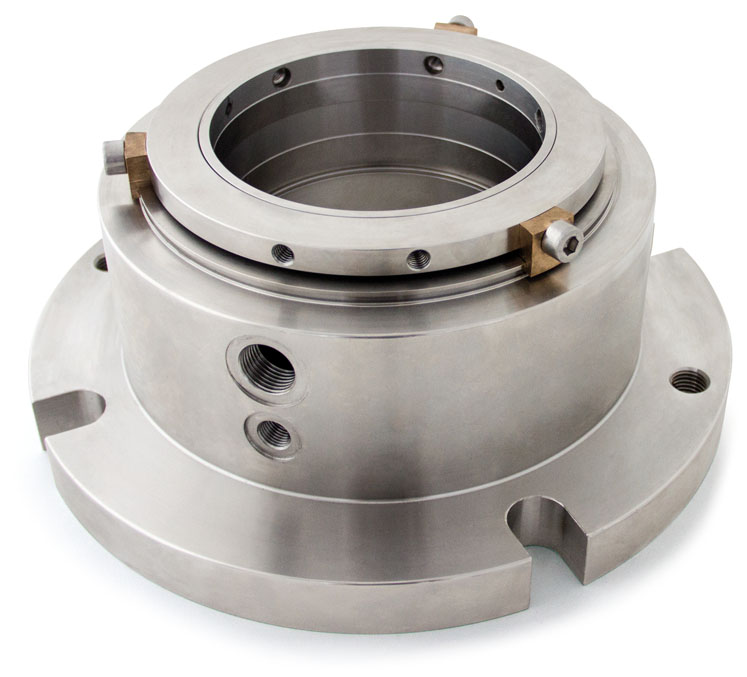In this article, John explains how, although often overlooked, seal and component selection can be central to improving the reliability of rotating equipment, as well as reducing the risk of process contamination and delivering long-term savings. There are two core concerns common to almost every pharmaceutical company — process containment to prevent leakage to the atmosphere and minimising the risk of product contamination.
The pharmaceutical industry can be commended for its adherence to the regulations relating to active pharmaceutical ingredients (APIs) and current good manufacturing practices (cGMPs) when it selects equipment such as mixers, reactors and dryers.
However, when it comes to considering the design and composition of the sealing components on that equipment, it seems perfectly content to accept outdated and inefficient technology compared with advanced, industry compliant modern sealing solutions that are proven to eliminate leakage and reduce the risk of product contamination.
There are various reasons for this, not least the simple fact that many companies are reluctant to embrace change. This is somewhat because the subsequent need to amend change and recipe controls is deemed to be too onerous, partly because of the difficulty involved in getting proposed changes signed off at a higher level — even for senior production engineers — and partly because old habits die hard.
Then there’s the fact that mechanical seals are a comparatively small component whose significance can be easily ignored … and that outdated mechanical seals and support systems are routinely specified on new equipment as a way of keeping overall costs down.
The upshot of this is that a pharmaceutical plant can have a critical asset — even a modern one — fitted with original equipment manufacturer (OEM) sealing technology and materials that are 25 years out of date. A typical example would be a single balanced seal with seal face materials made from poor quality carbons, ceramics or Ni-resist materials, and PTFE wedges as the primary sealing element.
PTFE wedges are fast-wearing and unreliable. They seal directly to the shaft, fretting against it and causing damage that allows process fluids to leak into the barrier fluid that keeps the seal faces lubricated and cool. As such, the risk of contamination is in-built. Seal failure is swift and inevitable. And yet the typical response to such failures is to replace the exact same seal at the exact same point on the already damaged shaft, creating a downward spiral of failure.

John Smiddy
It’s hard to imagine that these outdated seals are still being used today, let alone on new equipment. The OEM seal might not be the primary concern when buying a new mixer, but once that mixer is out of warranty the seal becomes far more important in terms of its impact on overall reliability.
This is why best-in-class companies place equal importance on sealing solutions and materials as on the mixer, reactor or dryer being purchased. A number of options are available to the pharmaceutical company seeking to achieve zero emissions and minimise contamination risk.
First, any selection should incorporate “double balanced” seal technology to guarantee the high level of containment required by industry standards. Double balanced seals recognise the pressure-to-vacuum operating change and always keep the faces closed, eliminating leakage. They can also be made from more hygienic designs and materials selections, so are ideally suited to environments requiring high levels of hygiene.
Wet seal technology
The wet seal is the most common sealing solution on pharmaceutical production lines. These are pressurised using a barrier fluid, such as food grade oil or purified water, supplied to the seal faces via a support system. The viscosity of the barrier fluid itself is key; too thick and it will force the seal faces apart, increasing leakage.
Where outdated seals are fitted, these also bring the problems of shaft fretting, leakage and recurrent failure, with the downtime and repair/replacement costs that incurs. But the seal support system is an even more serious weak spot in terms of contamination.
All mechanical seals leak a tiny amount of barrier fluid that will inevitably enter the production process; so, the cleanliness of the fluid and its container is crucial. Barrier fluid generally sits at a temperature of 30/40 °C — an ideal breeding ground for bacteria.
If it isn’t changed frequently, it quickly becomes impure. Ideally, barrier fluid should be changed every day; in reality, it can be months before it is replaced with clean fluid. Traditional seal support vessels are difficult to access (you need a camera to view the interior), so there’s no guarantee they’re 100% clean and free from contamination.
The first sign of contamination is in the container designed to pick up any leakage when a seal fails. It couldn’t be more obvious; if the leaked fluid is a dirty black colour, it’s a clear sign of contamination.
The case against using wet seal technology therefore begins to mount. However, the right wet seal technology can mitigate the risk of leakage and contamination. Modern, double balanced mixer seals made from US Food and Drug Administration (FDA)-compliant materials such as silicon carbide will, with the correct viscosity of barrier fluid, eliminate any leakage beyond the accepted level.
They are not integral to the equipment and use chemical resistant compounds such as perfluoro elastomers (Kalrez), so do not damage the shaft. They also withstand a wide range of pressure and vacuum conditions.
Most importantly, advanced seal support systems, specifically designed for ultrahygienic environments, are now available. They can be disassembled for easy inspection and cleaning. The small volume of liquid being emitted by the seal can be easily monitored via an external panel, pre-empting failure and downtime. Perhaps the most persuasive factor for pharmaceutical companies wary of change is that this type of seal support system can actually be cheaper than traditional systems.
Dry gas seal technology
Dry gas seal technology presents two options: contacting and non-contacting seal face designs. The barrier between the inboard and outboard seal faces is gas, not the traditional liquid. This gas requires a humidity level of less than 5%, using the correct choice of seal face material, so there is no need for a humidifier and no risk of the contamination that wet gas would bring.
Material selection is key when it comes to dry gas contacting seal faces; it should be a highly tested FDA-compliant carbon. This type of carbon has molybdenum disulphide (MoS2) embedded in it, which comes to the surface once heat is generated, much like perspiration coming to the surface on the palm of one’s hand.

Short canister mixer seal
Dry gas contacting seals can perform better and longer than wet seals. Testing results have proven that a dry gas contacting seal working on a mixer/reactor/dryer at a maximum duty of 25 bar m/s will work for approximately 8000 hours. Bearing in mind that most mixers operate at just 0–5 bar m/s, this seal would operate for roughly 50,000 hours on normal duty.
It also means that seal life can be predicted based on the running conditions. In an upset condition, such as a mixer running at low level, if the inner seal leaks, the external remains closed and the seal recovers quickly. ATEX range certification for zones zero, 1/21 and 2 /22 are another bonus with this type of product.
The support system for dry gas seals — a simple, easy to read display panel — represents another significant advancement for reliability engineers. The panel is simple to read, with visible gas flow indicators, a flow switch and pressure switch, which are designed to alarm on a seal upset condition or pre-empt a possible seal failure condition.
It’s hard to believe, but pharmaceutical companies will happily spend anything from £10,000 to £50,000 on a dry gas seal provided by OEMs, which often comes without a display panel. If you bought a new car and there was no display panel on the dashboard, would you drive it?
Dry non-contacting seal face designs
The faces of dry non-contacting seals are etched to keep them apart; they hover above each other. They work well for mixers and reactors; however, they are extremely sensitive to running conditions. If the gas supply is lost for any reason and they touch, the seal faces will be irrevocably damaged. Gas pressure and flow must be consistent and equipment perfectly aligned. Even submicron particle migration across the seal faces can be deadly.
All this begs the question, why choose this sealing technology? The answer is that, because the seal faces are non-contacting, there is no risk of contamination through seal face material selection … so they are often specified at the end of the process line, which is hyper-sensitive to any contamination.
But they should always be selected with an awareness of their flaws. Non-contacting seal face designs, used under the right process conditions and with the correct seal support systems, can be an effective sealing solution. However, in my experience, it is difficult for facilities to maintain the correct and ideal running conditions, so it is difficult for this option to be recognised as a reliable seal solution across many applications.
So, which sealing solution would the judicious purchaser pick? In most applications, the most reliable choice has got to be dry gas contacting seals — also, incidentally, the first choice of all the major pharmaceutical companies. The improvement in reliability has been huge — increasing mean time between failures (MTBFs) from one year to five in many cases — and costs haven’t risen in line with these advances.
Surely, that is reason enough for the pharmaceutical industry to not just accept, but to embrace, change.




